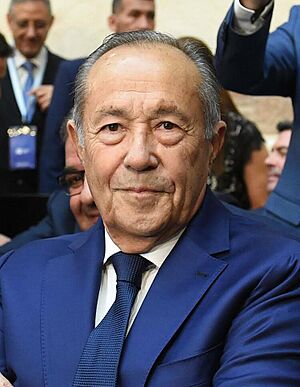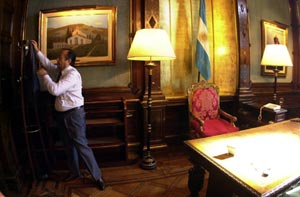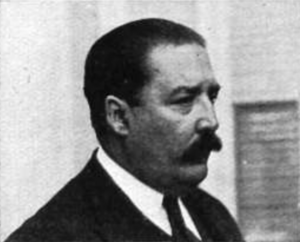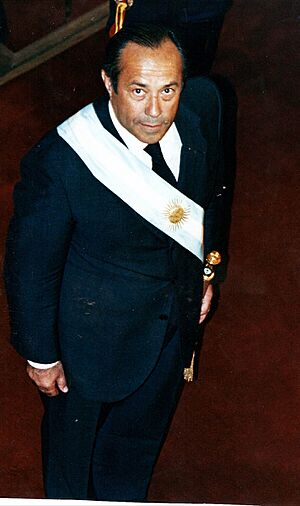Adolfo Rodríguez Saá facts for kids
Quick facts for kids
Adolfo Rodríguez-Saá
|
|
|---|---|

Rodríguez-Saá during the inauguration of Javier Milei, December 2023
|
|
| National Senator | |
| Assumed office 10 December 2005 |
|
| Constituency | San Luis |
| 53rd President of Argentina | |
| Interim 23 December 2001 – 30 December 2001 |
|
| Vice President | None |
| Preceded by | Ramón Puerta (acting) |
| Succeeded by | Eduardo Duhalde (interim) |
| National Deputy | |
| In office 10 December 2003 – 9 December 2005 |
|
| Constituency | San Luis |
| Member of the Constitutional Convention | |
| In office 30 May 1994 – 22 August 1994 |
|
| Constituency | San Luis |
| Governor of San Luis | |
| In office 10 December 1983 – 22 December 2001 |
|
| Vice Governor | Ángel Rafael Ruiz (1987–1991) Bernardo Quincio (1991–1995) Mario Merlo (1995–1999) Alicia Lemme (1999–2001) |
| Preceded by | Hugo di Risio (de facto) |
| Succeeded by | Alicia Lemme |
| Personal details | |
| Born | 25 July 1947 San Luis, Argentina |
| Political party | Justicialist Party |
| Other political affiliations |
Federal Commitment (2010–2015) Juntos por el Cambio (2019) Frente de Todos (2019–present) |
| Spouse | María Alicia Mazzarino |
| Parents | Carlos Juan Rodríguez-Saá Lilia Ester Páez |
| Alma mater | University of Buenos Aires |
| Signature |  |
Adolfo Rodríguez-Saá (born 25 July 1947) is an Argentine politician. He comes from a very important family in the history of the San Luis Province. He became the province's governor in 1983, after a military government ended. He was governor until 2001, winning many elections.
In 2001, the president at the time, Fernando de la Rúa, resigned because of big protests. The country's Congress chose Rodríguez Saá to be the new president of Argentina. During his short time as president, he announced that Argentina would not pay its huge national debt. He resigned just a few days later because of more public unrest.
The Congress then chose a new president, Eduardo Duhalde. Rodríguez Saá later ran for president in 2003 and 2015, but he did not get enough votes to win.
Contents
Early Life and Education
Adolfo Rodríguez Saá was born in San Luis. His family was very important in politics there. His grandfather, also named Adolfo Rodríguez Saá, and his great-uncle were both governors of the province. His father was a police chief.
He went to the "Juan Pascual Pringles" school. Later, he studied law at the University of Buenos Aires and finished in 1971. For two years, he worked as a teacher at his old school. He became interested in politics and joined the Peronist Youth group in 1971.
In 1973, the Peronist party was allowed to run in elections again. Rodríguez Saá became a lawmaker for his province. He led the Peronist lawmakers in the local assembly. After a military takeover in 1976, he stopped working in politics for a while. He worked at a law firm with his brother.
Governor of San Luis
The military government ended in 1983. Raúl Alfonsín won the national elections. In the same elections, Adolfo Rodríguez Saá was chosen as the governor of San Luis. It was a very close election.
As governor, Rodríguez Saá worked hard to bring new businesses and money to San Luis. This helped local industries grow. It also led to more public projects, better social services, and more tourism. The province saw more jobs and higher production. Schools and efforts to fight crime also improved. He was a strong leader who focused on helping his province grow. He also brought together governors from smaller provinces to work together.
He tried to become president in 1989, but Carlos Menem won the primary election and became president. Rodríguez Saá was part of the group that helped write changes to the Argentine Constitution in 1994. He also tried to run for president in 1995 and 1999, but he decided not to continue his campaigns. He was re-elected as governor of San Luis many times.
A Short Time as President
In December 2001, Argentina was facing a big economic crisis and many protests. President Fernando de la Rúa resigned. Since his vice president had also resigned earlier, the Congress had to choose a new leader. Ramón Puerta was acting president for a very short time. Then, Adolfo Rodríguez Saá was chosen by Congress to be the new president. He took office on 23 December 2001.
Congress asked Rodríguez Saá to call for new elections very soon. The new president would then finish the term of the previous president.

During his short time as president, Rodríguez Saá made a big announcement. He said that Argentina would not pay its huge national debt. This is called a sovereign default. It was the largest one in history at that time. Many lawmakers in Congress were happy about this decision. He also talked about creating a new type of money called the argentino.
However, there were still many protests. Some political leaders also stopped supporting him. On 30 December 2001, Rodríguez Saá went back to San Luis and resigned. He said he did not have enough support from other politicians. His resignation was accepted on 1 January 2002. After more discussions, Eduardo Duhalde was chosen as the new president.
After the Presidency
After Eduardo Duhalde's term ended, Rodríguez Saá ran for president again in 2003. He was one of several candidates from his party. He came in fourth place in the election. Néstor Kirchner became the president after that election.
In 2003, Adolfo Rodríguez Saá's brother, Alberto Rodríguez Saá, became the new governor of San Luis. Adolfo Rodríguez Saá was later elected as a Senator for San Luis in 2005. He was re-elected in 2011 and served until 2017.
He ran for president again in 2015 with his own political party. He received a small number of votes. Later, he joined different political groups, including one that supported President Mauricio Macri and then one that supported President Cristina Kirchner.
Images for kids
See also
 In Spanish: Adolfo Rodríguez Saá para niños
In Spanish: Adolfo Rodríguez Saá para niños






